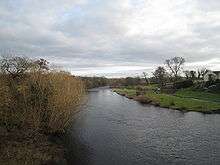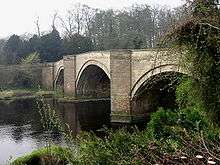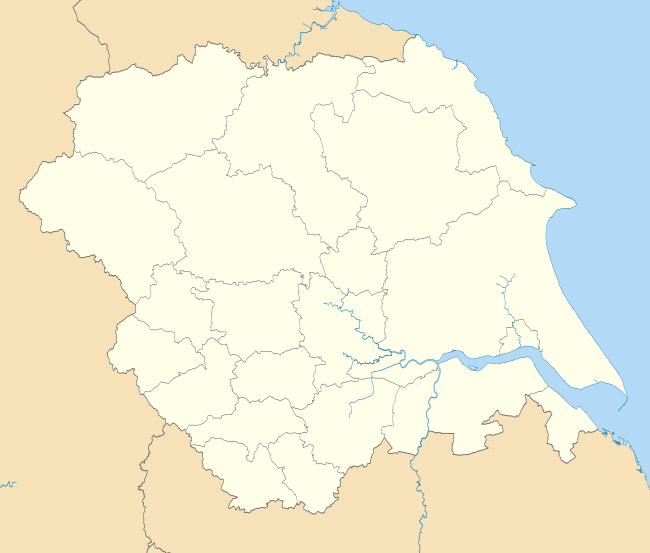Cliffe, Richmondshire
Cliffe is a small village and civil parish in the Tees Valley near Piercebridge in the Richmondshire district of North Yorkshire, England, about 6 miles (10 km) west of Darlington, and 10 miles (16 km) north of Richmond and the Yorkshire Dales. The population of the civil parish as taken by ONS at their 2011 Census was less than 100, so information is included in the parish of Manfield. In 2015, North Yorkshire County Council estimated the population to be 30.[1]
| Cliffe | |
|---|---|
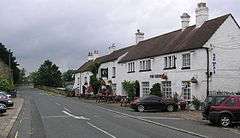 George Hotel at Cliffe | |
 Cliffe Location within North Yorkshire | |
| Population | 30 |
| OS grid reference | NZ213154 |
| District | |
| Shire county | |
| Region | |
| Country | England |
| Sovereign state | United Kingdom |
| Post town | Darlington |
| Postcode district | DL2 |
| Dialling code | 01325 |
| Police | North Yorkshire |
| Fire | North Yorkshire |
| Ambulance | Yorkshire |
| UK Parliament |
|
Cliffe has a long history, as shown by the number and range of archaeological sites from tumuli to an English Civil War battleground, most of which are scheduled monuments. A stream called the Glen runs through the village to the Tees. Together with Manfield, Aldbrough St John and Melsonby it forms the ward of Melsonby whose total population recorded at the 2011 census was 1,406,[2] and the area is largely agricultural. The village is notable for its 17th-century Grade II listed George Hotel, where the story behind the song, My Grandfather's Clock, is said to have originated in 1875.
History
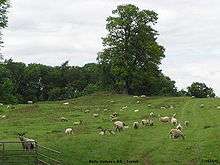
There is evidence of Stone Age, Iron Age, Roman and medieval activity here, although the name "Cliffe" appears to be a medieval name possibly referring to Cliffe Hall and its park.[3] Cliffe has no church, but it does have its own parish, possibly due to the previous existence of a chapel at Cliffe Hall.[4] At least part of Cliffe shares the Piercebridge postal address, although Piercebridge is north of the Tees, in County Durham: hence some Cliffe locations are described in some records as Piercebridge locations.[4] This area, being close to Manfield, was part of the Gilling West wapentake at the time of the Norman Conquest, so that the later Manfield parish, which included Cliffe, had 2,754 acres (11.15 km2) in Gilling East wapentake and the 700 acres (2.8 km2) comprising Cliffe in Gilling West wapentake.[3][5] In 1717 there were places in Cliffe known as Haverfield, Willow Pound, Stonebridge-fields, Scroggy Pasture, Lime Kill-fields and Carlberry, together with the 13th-century mill and mill-dam.[6] In the early 1820s, the village was described thus:
"Cliffe, in the parish of Manfield, wapentake of Gilling West, and liberty of Richmondshire; (the seat of Henry Witham, Esq.) 1½ miles NNW. of Manfield, 6 miles WNW. of Darlington. Here is no place of worship, except a Catholic chapel, the Rev. William Hogarth, minister, Cliffe hall. Pop. 53."[7]
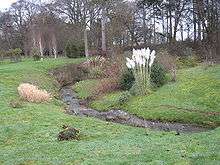
The Georgian mansion Cliffe Hall was sold in 1825 by the Withams to the Wilsons, who rebuilt it in 1859. In 1890 the 700 acres (2.8 km2) of Cliffe were the property of Colonel Wilson. The rateable value was £960, and population 72. The village was said to have derived its name from the cliffs along the river.[5] Cliffe is again described as part of Manfield parish in 1914:
"The park of Cliffe Hall was formed in the 13th century . . . it is surrounded by plantations and traversed by a little stream, the Glen, that finds its way to the Tees. There are tumuli in the park. A lane from Cliffe crosses Watling Street and runs through Manfield to Cleasby . . . In 1717 the lord of Cliffe owned a ferry across the Tees at Manfield."[6]
The area at Cliffe Bank was affected by foot and mouth disease in 2001.[8]
Geological and political landscape
The subsoil is magnesian limestone and recent alluvium by the Tees; the soil is a strong clay on a gravelly and sandy subsoil. In 1914 the chief crops raised were wheat, oats and turnips, the occupation of the people being mainly agricultural.[3] In 1868 the land was "divided between arable and meadow, with about 80 acres of woodland".[9] In 2007 the population for the whole of the Richmondshire 001D area, which includes Manfield, Aldbrough St John and Melsonby, was 1,447 residents and 619 dwellings; however Cliffe is much smaller than the other villages in the 001D area.[10] It is in the Melsonby ward, and its councillor is Jimmy Wilson-Petch.
Local landmarks
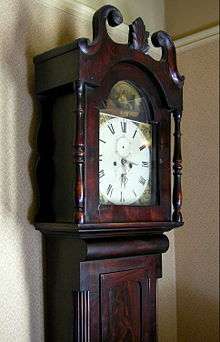
The most obvious local landmark is the River Tees on which the village stands. The Grade II listed George Hotel stands near the road-bridge which crosses the Tees coming from Piercebridge, and is said to be the home of My Grandfather's Clock which "stopped short never to go again when the old man died".[4][11][12] The 1789 bridge is the local major crossing since the Roman bridge on Dere Street was destroyed.[13][14] This bridge, of which the northern half is in County Durham and the southern half is in Richmondshire, is close by the old Roman road.[15] Kathleen Wood is next to Cliffe Hall, a surviving Victorian extension of a long-destroyed Georgian mansion. It is now a bed and breakfast establishment.[16][17]
Cliffe residents and visitors
All Saints church at Manfield, with which Cliffe once shared a parish, contains windows and monuments dated from the 16th to 19th centuries, dedicated to the Witham and Wilson families of Cliffe Hall.[5] The hall came into possession of the Withams by the marriage of George Witham, Esq., with Margaret, daughter and co-heir of John Wawton, of Cliffe. She died in 1479, and is buried at Manfield.[5] Cliffe Hall with its chapel had its place in British clerical history: the Reverend William Hogarth, the first Bishop of Hexham 1850–1861, came from Cliffe. Henry Thornton Maire Witham was the priest at Cliffe chapel in 1800, and he had ten children. The youngest son, Thomas Edward, was baptised in the chapel in 1806, and later became a missionary. After the chapel was closed, T.E. Witham built St Mary's church at Gainford around 1855.[18]
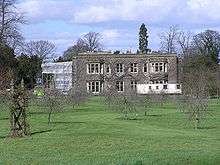
Thomas Wright was farmer and corn miller in 1823, possibly at Clowbeck Mill.[19] Henry Clay Work, the American composer of Marching Through Georgia, visited Cliffe and heard in 1875 of the odd incident in the George Hotel when the grandfather clock stopped the moment its owner died. He wrote a celebrated song about it.[20] In 1890, John Gerald Wilson Esquire of Cliffe Hall was a County Magistrate for Gilling West Petty sessional division. Bulmer's Directory 1890 describes him as "Wilson John Gerald, J.P., D.L., Colonel commanding the West Yorkshire Brigade of Volunteers, and 3rd York and Lancashire Regiment of Militia; Alderman North Riding County Council, and ex-officio member of the Darlington Board of Guardians, Cliffe hall."[21] Ernest Hill, M.A. (Camb.), was at Cliffe Lodge in 1890, and John Dent was farmer and miller at Clowbeck Mill, with a possible relative William Dent running Clowbeck Farm.[22] Murrough John Wilson, J.P., of Cliffe was the lord of the manor of Manfield in 1914, and later Conservative MP for Richmond.[6]
Archaeological sites
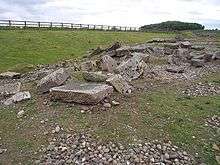
Most of the following are scheduled monuments. The Georgian foundations of the original Cliffe Hall, and the remains of a vicus, lie separately under ground nearby.[23][24][25] Medieval noblemen are said to have escaped persecution by going through the mythical Hell Hole tunnel in the cliff to Cliffe Hall.[26] An artefact said to be a market cross is still visible in the fields alongside the mounds where the buildings of the vicus were.[27] However this may be identical with the medieval Cliffe Park wayside cross which is dated 1066 to 1539 and described as follows: "Remains consist of the upper part of the shaft with head and arms set into a modern socket stone. The remains do not appear to be in situ and no indication of its original location".[4][28] Also of archaeological interest is the tumulus known as Betty Watson's Hill.[29] The Piercebridge conservation area does not cover Cliffe due to county boundary limitations.[30] Cliffe forms part of the site of Piercebridge Battle, the "1642 Civil War skirmish between the Earl of Newcastle (Royalist) on the march to York, and Captain Hatham. Both sides had canon, and the Royalists who had canon on Carlbury Hill won the day. Hatham retreated to Tadcaster while the Royalists marched to York".[4][31][32] There is a linear feature, from near Namen's Leazes to near Crow Wood, which goes through Aldbrough, Stanwick St John and Cliffe; it could be an earthwork bank, a defence dyke or a trackway.[4][33] At Cliffe Park there is a double bank earthwork, probably a park pale; and between the banks a small, well-made cobbled track was identified.[4][34]
Digs and finds
Stone Age and Iron Age
A Neolithic leaf arrowhead dated 4000 to 2201 BCE was found at Cliffe.[4][35] It is thought that there could have been a late Iron Age trade route south-west from the bridge area at Cliffe to Reeth and Maiden Castle via Stanwick and Castle Steads.[36]
Bronze Age
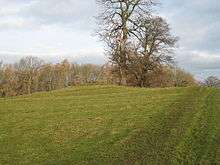
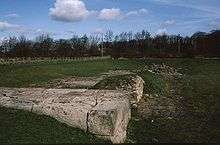
The Betty Watson's Hill Bronze Age barrow 1,120 feet (340 m) east of Cliffe Hall was excavated in 1904. It was described as a flat-topped bowl barrow, and it was noted that "the large hole in the centre is probably due to robbers or an unrecorded excavation".[37][38] In 2007, a cup-marked 29×23×16 cm boulder with two 5 cm cups was found in field-edge dumps 50m south-east of the Betty Watson's Hill barrow. "The cobble was removed from the field edge and placed back on the barrow top. This now puts an early Bronze Age date to the monument." The boulder is believed to have originated in the robbed-out barrow.[4][39] A round barrow is recorded 190m south-east of Cliffe Hall.[4][40]
Roman
In 1994, the observation of groundworks at the George Hotel and Cliffe substation recorded part of a Roman road as well as undated disturbance.[4][41] In the same year, a section through Dere Street was exposed by excavations carried out in a garage development area, and some pottery and tile found.[4][42] Excavations in 1982–1986 uncovered a vicus: an "area of Roman settlement on the south side of the River Tees. This area was bisected by the Roman road. Excavations and watching briefs have been undertaken. These have found buildings, kilns, clay occupation surfaces, Dere Street and many artefacts. Information is held on parish files."[4][43] The same vicus had been excavated around 1971: "Foundations of a Romano-British settlement were revealed by topsoil stripping. Excavation revealed a number of foundations of buildings, streets, ditches and much occupational debris. Occupation was onsite from the middle of the second century to the end of the fourth century. Settlement may lie on either side of Dere Street realignment."[4][44] In 1849, a Roman inscribed tombstone was found at Cliffe Bank.[4][45] According to the inscription, the tombstone was "erected by the wife for her husband called Gracilis, a centurion from Upper Germany in the XXII legion and sent to Britain in the early third century."[4][46]
Time Team investigation
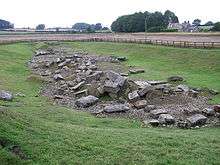
At the end of June to the beginning of July 2009, archaeological television programme Time Team investigated the Roman remains of Piercebridge Roman Fort and the supposed Roman bridge, and it is now suspected that the remains on the south bank are not a bridge at all, but the footings of a jetty, and that the location of the Roman bridge is unknown. A similar view had previously been suggested by Raymond Selkirk.[47] Gravel extraction in the 1940s and later landfill and landscaping on the south bank have hampered archaeology.[48]
Listed buildings
- George Hotel, formerly Bridge Inn, listed in 1968 as Grade II, no.322655 at location NGR: NZ2116615516 on the B6275 road. Listing description: parts of it date from the 17th, 18th and 19th centuries, and it includes a mounting block and chamfered ashlar fireplace.[49]
- The Piercebridge road bridge, of which the southern half is in Cliffe, listed in 1951 as Grade II*, number 322654 at location NGR: NZ2108215554. Listing description: early 16th century, repaired 1673, widened 1789; built of ashlar and coursed rubble sandstone. On the upstream side, the outer two arches are 16th-century, and the central arch is 1673; the parapet is 18th-century. The downstream side is dated 1789. The central pedestrian retreats on both sides have recessed panels with illegible inscriptions, and a similar panel in the southernmost downstream retreat. In the centre of the downstream parapet there are two recessed panels marking the boundary between County Durham and Yorkshire, the northern one with inscription "Co.D." just legible.[50]
References
- "2015 Population Estimates Parishes" (PDF). northyorks.gov.uk. December 2016. p. 15. Retrieved 12 September 2019.
- UK Census (2011). "Local Area Report – Melsonby Ward (as of 2011) (E05006286)". Nomis. Office for National Statistics. Retrieved 12 September 2019.
- William Page, ed. (1914). Victoria County History: A History of the County of York North Riding: "Parishes: Gilling". 1. pp. 71–84. Retrieved 11 January 2010.
- "Heritage Gateway". Listed buildings online, and local records. Archived from the original on 25 September 2005. Retrieved 11 January 2010.
- Hinson, Colin (2006). "Genuki UK and Ireland genealogy". Manfield: Geographical and Historical information from the year 1890:Transcript of the entry for the Post Office, professions and trades in Bulmer's Directory of 1890. Retrieved 12 January 2010.
- William Page, ed. (1914). "British History Online". Victoria County History: 'Parishes: Manfield', A History of the County of York North Riding: Volume 1. pp. 186–190. Retrieved 12 January 2010.
- Hinson, Colin (2006). "Genuki UK & Ireland Genealogy". The Ancient Parish of Manfield. Retrieved 12 January 2010.
- "UK foot-and-mouth cases round-up 2". BBC News. 19 October 2001. Retrieved 9 January 2010.
- Hinson, Colin (2006). "Genuki UK & Ireland genealogy". Transcribed from The National Gazetteer of Great Britain and Ireland 1868. Retrieved 12 January 2010.
- "Office for national statistics". DL2 3SW within neighbourhood Richmondshire 001D. 2007. Retrieved 13 January 2010.
- Howe, Stanley (9 October 2006). "Geograph". NZ2115 : George Hotel, Cliffe. Retrieved 9 January 2010.
- Photo of reputed original grandfather clock Archived 11 February 2010 at the Wayback Machine
- "Bill's Walks". Winston to Piercebridge (Teesdale Way). 25 April 2009. Retrieved 9 January 2010.
- Rogers, David (7 May 2009). "Geograph". NZ2115 : Tees Crossing at Cliffe. Retrieved 9 January 2010.
- "Tees Archaeology". Cliffe: aerial photo of Ancient Roman road and bridge in Cliffe. 2009. Archived from the original on 16 July 2011. Retrieved 9 January 2010.
- Sawday, Alistair (26 February 2005). "Guardian". The best meal of the day: Cliffe Hall, Yorkshire. London. Retrieved 9 January 2010.
- Image of Cliffe Hall Archived 24 December 2009 at the Portuguese Web Archive
- "Stosmund.org". St Osmund's Church: Clergy. Archived from the original on 18 February 2009. Retrieved 9 January 2010.
- Hinson, Colin (2006). "Genuki UK & Ireland genealogy". Transcript of the entry of "professions and trades" for MANFIELD in Baines's Directory of 1823. Archived from the original on 30 August 2008. Retrieved 12 January 2010.
- "How the Grandfather Clock Got Its Name". Archived from the original on 11 July 2011. Retrieved 12 January 2010.
- Colin Hinson; Peter Nelson, eds. (2006). "Genuki UK and Ireland genealogy". Transcript of the entry for the Post Office, professions and trades for Richmond in Bulmer's Directory of 1890. Retrieved 12 January 2010.
- Hinson, Colin (2006). "Genuki UK & Ireland Genealogy". Transcript of the entry for the Post Office, professions and trades for Manfield in Bulmer's Directory of 1890. Retrieved 12 January 2010.
- "Tees Archaeology". Cliffe Hall, North Yorkshire (aerial photo of site). 2008. Archived from the original on 16 July 2011. Retrieved 9 January 2010.
- "Piercebridge, Cliffe Hall". Durham County Council. Retrieved 12 December 2017. – Photo of Cliffe Hall taken 1905–1918
- This vicus is often mistakenly referred to as a lost medieval village, but the nearest one is Ulnaby Village in County Durham, excavated by Time Team in episode 205.
- Lloyd, Chris (6 November 2009). "The Northern Echo". Baffled by Barforth, full of history and mystery. Archived from the original on 27 September 2012. Retrieved 9 January 2010.
- Muir, Richard (27 October 2009). The Lost Villages of Britain. The History Press Ltd. p. 240. ISBN 978-0-7509-5039-8.
- NY SMR Number MNY12764; National Monuments Record NZ21NW29; Grid Reference NZ 206 150; Heritage Gateway SNY1 Card Index Ordnance Survey Record Card NZ21NW29
- "Tees Archaeology". Cliffe, Betty Watson's Hill (aerial photo). 2009. Archived from the original on 16 July 2011. Retrieved 9 January 2010.
- "Darlington Borough Council" (PDF). Piercebridge conservation area character appraisal, with map. January 2006. p. 10. Retrieved 9 January 2010.
- NY SMR Number MNY12771; National Monuments Record NZ21NW55; Grid Reference NZ 21 15; Heritage Gateway SNY1 Card Index Ordnance Survey Record Card NZ21NW55
- Wooler (1905). "Internet Archive". Royal Canadian Institute of the Society of Antiquaries of Newcastle Upon Tyne, 3rd Series, Vol.1. R. Simpson & Sons. pp. 130–131. Retrieved 14 March 2010.
- NY SMR Number MNY15332; Grid Reference NZ 207 142; Heritage Gateway SNY6982 Card Index North Yorkshire County Council Fieldwalking Cards NZ 21 SW FW 1
- NY SMR Number MNY25352; Old Sites & Monuments Record Number 12933; Grid Reference NZ 210 151 ; Heritage Gateway SNY1 Card Index Ordnance Survey Record Card NZ 21 NW FW1
- NY SMR Number MNY12770; National Monuments Record NZ21NW46; Grid Reference NZ 20 10; Heritage Gateway SNY1 Card Index Ordnance Survey Record Card NZ21NW46
- "Brigantes Nation". Piercebridge Roman Fort, Vicus and Riverworkings. 2002. Archived from the original on 2 October 2008. Retrieved 12 January 2010.
- Proceedings of the Society of Antiquaries of Newcastle upon Tyne 1.15/1904 130, Excavation at Cliffe Park OSGB Grid ref. – NZ 20 15 Lat/Lon (OSGB36) – 001 41 W 54 31 N, ADS record ID EHNMR-647393
- NY SMR Number MNY12766; National Monuments Record NZ21NW31; Grid Reference NZ 210 152; Heritage Gateway SNY1 Card Index mentions Ordnance Survey Record Card NZ21NW31
- NY SMR Number MNY25352; Grid Reference NZ 210 152; Heritage Gateway SNY11865 Correspondence P & B Brown, Cup marked stone, Brown P. Printout, 2007/06/12
- NY SMR Number MNY12765; Scheduled Monument 29524, Grid Reference: NZ 208 151; National Monuments Record: NZ21NW30; SNY11216 – Report: English Heritage. 26 April 2006. NMR complete monument report
- (1) North Yorkshire County Council Archaeology Section [assessment & evaluation reports] Campling N & Kilpatrick A/1994/George Hotel, Piercebridge: recorded observation, and (2) CBA Forum: The annual newsletter of CBA Group 4 1994 36, respectively
- NY SMR Number MNY12855; Old Sites & Monuments Record Number 12975.10000; Grid Reference NZ 212 155; SNY8056 Field recording Form, North Yorkshire County Council 15 November 1994, George Hotel Piercebridge (Dere Street Cottage), Campling, N. NYCC Observation Record
- NY SMR Number MNY12854; National Monuments Record: NZ21NW2; Grid Reference NZ 212 154, SNY8056 – Field recording Form: North Yorkshire County Council. 15 November 1994. George Hotel, Piercebridge (Dere Street Cottage). Campling, N. NYCC Observation Record
- NY SMR Number, MNY12768; National Monuments Record NZ21NW39; Grid Reference NZ 214 154; SNY1446 Unpublished document: Department of the Environment 1971 Archaeological excavations P54
- NY SMR Number MNY12762; National Monuments Record NZ21SW11; Grid Reference NZ 213 147; SNY1690 Article: Archaeological Journal 1849 "On the Roman roads, camps and other earthworks between the Tees and the Swale" MacLaughlan H., photocopy. P218 map
- NY SMR Number MNY12767; Grid Reference NZ 20 10; National Monuments Record NZ21NW32; SNY1404 1965, The Roman inscriptions of Britain, Collingwood RG and Wright RP, P341
- Selkirk, Raymond (2000). Chester-le-Street & Its Place in History. Birtley, County Durham: Casdec Print & Design Centre. pp. 93–122. ISBN 1-900456-05-2.
- Lloyd, Chris (2 July 2009). "The Northern Echo". Piercebridge: Time Team investigates. Archived from the original on 27 September 2012. Retrieved 12 January 2010.
- Historic England. "George Hotel (1179351)". National Heritage List for England. Retrieved 11 December 2014.
- Historic England. "Pierce Bridge (1131363)". National Heritage List for England. Retrieved 11 December 2014.
Bibliography
- Muir, Richard, The Lost Villages of Britain (The History Press Ltd, 1 July 2008) ISBN 0-7509-5039-0, ISBN 978-0-7509-5039-8
- Page, William (editor),"Parishes: Gilling", in Victoria County History: A History of the County of York North Riding: Volume 1 (1914) pp. 71–84. Date accessed: 11 January 2010.
- Page, William (editor), "Parishes: Manfield", in Victoria County History: A History of the County of York North Riding: Volume 1 (1914), pp. 186–190. Date accessed: 11 January 2010.
External links
- Heritage Gateway: source for North Yorkshire archaeological records.
- The George Hotel grandfather clock
- Yorkshire 1823 wapentakes map
- Yorkshire North Riding pre-1832 parishes map
- 'England – Yorkshire: 014', Ordnance Survey 1:10,560 – Epoch 1 (1857) Date accessed: 14 January 2010.
- Holme House Villa
- Roman fort on Holmes House Farm
| Wikimedia Commons has media related to Cliffe, Richmondshire. |
